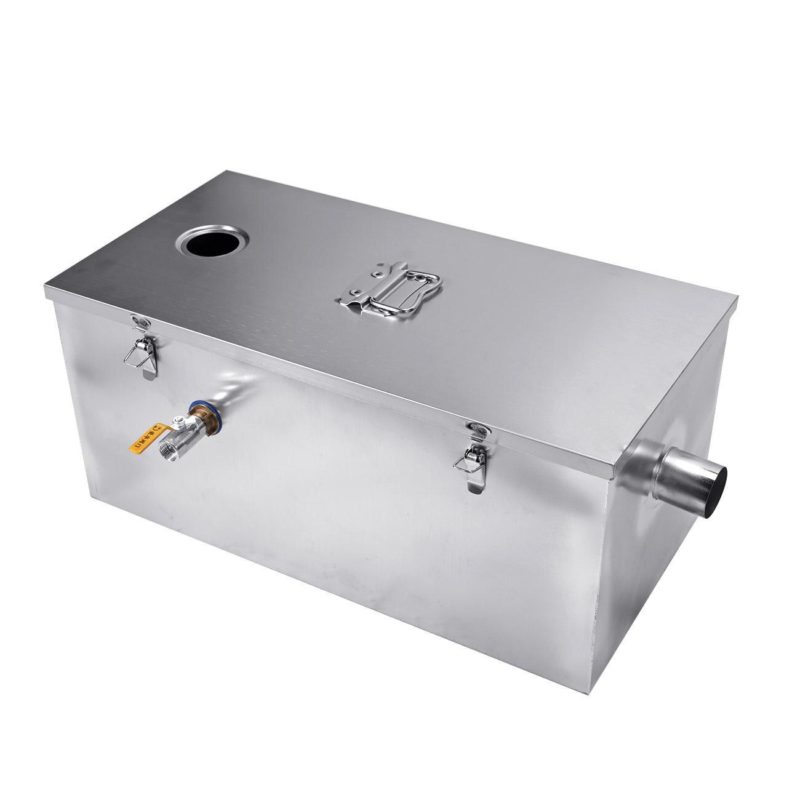Oil Trap
DESIGN and OPERATION:
The designs of OIL INTERCEPTORS are based on the common notion of specific gravity difference between the oil and the wastewater, as a recognized factor by plumbing engineers.
Based on this design criterion, most of the suspended solids will settle to the bottom of the separator as a sediment layer, the oil will rise to top of the separator, and the wastewater will be the middle layer between the oil on top and the solids on the bottom. In an installed trap 1/8” above the static water level is an adjustable draw off valve. This valve skims the oil rising to the surface inside of the interceptor. This oil is drawn off to a separate holding tank. The bucket, which retains solid material, needs to be lifted out of the interceptor for emptying at appropriate intervals. Interceptors should not be located directly in traffic areas. If required, specify extra heavy duty traffic cover.
The manufacturing process adheres to Canadian standard CAN/CSA-B481 SERIES-07.

DESCRIPTION
ALPINE Oil Interceptor is coated inside and outside fabricated steel with required rating. Unit shall include sediment bucket made of Stainless steel, deep seal trap, secured and removable cover, adjustable automatic draw-off assembly, 2” double vent connections, The Units are used where spillages of oil or diesel could occur, to help prevent the pollution of rivers, streams, drainage systems and water treatment plants., horizontal inlet/outlet, 2” adjustable draw off inlet.
DIAGRAM OF ALPINE OIL INTERCEPTOR
(Since the dimensions and other parameters are subject to change without notice;
Therefore, always please refer to technical offer)
INSTALLATION and MAINTENANCE
This unit should be installed so that the inlet receives the incoming drain line and the outlet dumps into the outgoing drain line. The draw off valve should be connected to a holding tank to receive the waste oil.
Maintenance
Draw off
- Commissioning Period
- The unit should be checked after the first 4 weeks of operation to note the buildup of oil. Based on the amount of oil in the holding tank, a regular cleaning schedule should be implemented to ensure that the waste oil is emptied before filling the holding tank. A back up in the interceptor, or a sluggishness in the draining of the fixture indicates that it requires cleaning. A regular inspection of the internal condition of the interceptor will explain how oftenly it requires cleaning.
- Routine Maintenance
- Remove main cover, drain off oil empty and clean sediment bucket, baffles assembly.
- Annual Maintenance
- Drain and clean interceptor tank completely. Check for paintwork deterioration, and treat as required. Check joints and seals.
SIZING FOR ALPINE OIL INTECEPTOR
Correct sizing of ALPINE Oil interceptor is important and crucial:
This unit should be installed so that the inlet receives the incoming drain line and the outlet dumps into the outgoing drain line. The draw off valve should be connected to a holding tank to receive the waste oil.
- 1. It avoids under-utilisation due to excessive over-sizing.
- 2. It avoids back flow of oily waste water due to under-sizing.
- 3. It ensures adequate hydraulic retention time of oily waste water in the interceptor, to achieve optimum separation of oil from water, and thus the maximum % of interception of oil.
Steps to size the Oil Interceptor
- 1. Estimate the peak volume of waste water [see note i] either in litres /sec. or gallon/min.
- 2. Select the oil interceptor model with flow rating equal to peak volume.
- 3. Provide storage tank [see note ii] size sufficient to accommodate the volumes of liquids to be having the anticipated frequency of removal.
(A) Sizing Method
(1) Covered Area
Peak Flowrate:
Total of hose outlets, equipments etc., that continuous discharging to drain line at one time
Example: (Waste Water from Washing sinks)
Sink size: 40 X 30 X 15 cm = 18,000 cc = 18 Litres
To fill up the sink with full water, and discharge it, and to check the time taken to fully discharge the water. It is recorded the time taken is about 30 seconds.
Thus, the flowrate is 18 litres /30 sec. = 8 GPM
(2) Open Area (Uncovered)
Peak Flowrate :
Total area (Length(meter) x Width(meter) x Rainfalls (mm/sec.)
Example: (An open car wash bay area) .
Length = 20 meter, Width=10 meter, Rainfall = 50 mm/hour
Therefore, Peak Flowrate = (20 x 10 x 50/3600 = 2.78 litres / sec.
(B) Sizing for Oil Storage Tank
- To estimate the volume of oil into the interceptor
- Frequency of maintenance routine (once a month, twice a month, etc.)
- Size the oil storage tank double the size of the total accumulated oil during the period {50% of oil + 50% of water) to cater for the requirements.
Example: An average of 5 litres daily of black oil is spilled and washed away into the drain lines. Assuming that the contractor (licensed by DOE) is scheduled to come and collect the waste black oil once a months. The total black oil accumulated in 30 days time is about 150 litres. The capacity for oil storage should be double = 300 liters.
Note: The above sizing methods are just a guideline only. In order to achieve a better effluent water range, kindly refer to the manufacturer/supplier for further advise.
Oil Hover
- The Oil Hover is compact, lightweight and portable — weighs around 8 lbs.; can be used to extract tramp oil from Oil Interceptors.
- Oil Interceptor. Enhances the efficiency of
- Made of stainless steel or steel with a powder coat finish — durable and corrosion-resistant.
- Self-tensioning stabilizer bar — keeps skimming belt under constant, even tension.
